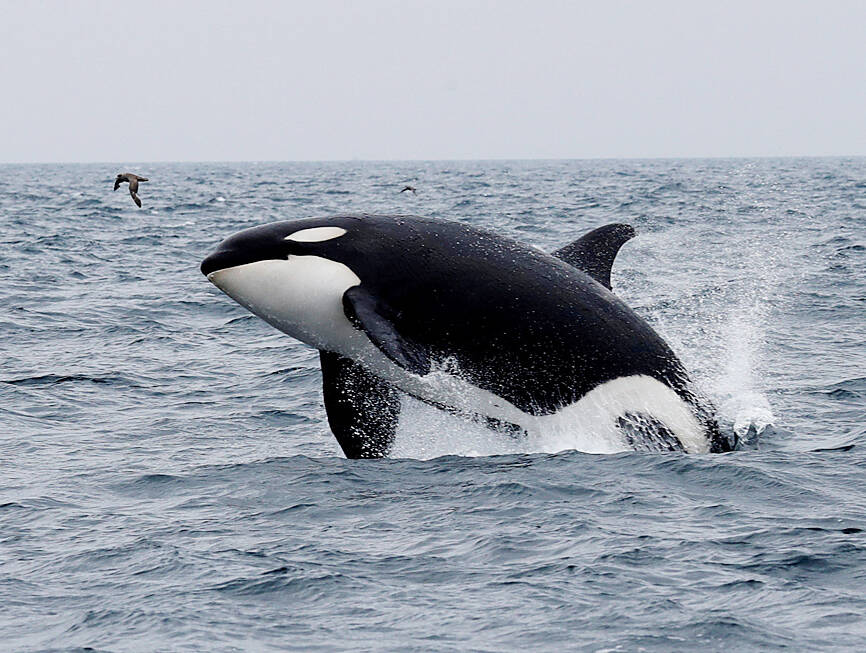Scores of disemboweled sharks have washed up on a South African beach, putting the spotlight on a pair of shark-hunting killer whales whose behavior has fascinated scientists and wildlife enthusiasts.
Marine biologists were alerted to the find by beach walkers who stumbled upon the grim sight last week in Gansbaai, a small fishing port 150km southeast of Cape Town.
“The dead sharks are torn open at the pelvic girdle, they have orca teeth marks known as rake marks on their pectoral fins and their liver is missing,” said Alison Towner, 37, a shark scientist with the Dyer Island Conservation Trust.

Photo: Reuters
All evidence points to “Port” and “Starboard,” an infamous pair of killer whales spotted off Gansbaai only three days earlier. Recognizable by their twisted dorsal fins, the animals are well known to locals as having developed a penchant for sharks.
“We found in total 20 sharks,” said Ralph Watson, 33, a marine biologist with local conservation and diving group Marine Dynamics.
The victims included 19 broad nosed sevengill sharks and one spotted gully shark, he said.
Towner said the slaughter was noticeable as it was the first time that Port and Starboard had hunted those species in the area and “so many of them washed out after one visit.”
Yet, it was not the orcas’ most daring hunt.
Experts credited the duo with having caused white sharks, one of the world’s largest sea predators, to disappear from some of the waters near Cape Town.
Last year, Starboard and another four orcas were captured on camera chasing and killing a great white off Mossel Bay, a southern port town.
The unusual behavior had never been witnessed in detail before.
Orcas, the ocean’s apex predator, usually hunt dolphins in those parts and have been known to prey on smaller shark species, but evidence of attacks on great whites was previously limited.
Port and Starboard were first spotted near Cape Town in 2015.
“They probably came from somewhere else. West Africa, east Africa, the Southern Ocean, we don’t know,” said 45-year-old Simon Elwen, who heads Sea Search, a scientific collective.
Unlike other killer whales, the pair likes to hunt near the coast — something that has made their peculiar fins a common sight in the region.
“Within southern Africa, Port and Starboard have been seen from as far west as Namibia to as far east as Port Elizabeth,” Elwen said.
The marine mammals’ killing technique is “surgical,” added Watson, adding that the pair target the sharks’ liver, “a very nutritious organ, full of oils.”
“They tear open the pectoral girdle chest area ... then the liver flops out,” Watson said.
Last year’s video showing Starboard in action has worried biologists, as it suggests the practice is spreading, with studies having established that the black and white animals have the capacity to teach hunting techniques.
Some Antarctic orcas use the cunning tactic of hunting in packs and making waves to wash seals off floating ice, researchers have found.
In the Antarctic two orca populations — not subspecies, but different groups that overlap at the margins — used very different hunting techniques, taught across generations.
Such behavior is not hard-wired, but learned — one of the arguments for suggesting that whales have “culture.”’
In the clip, the other four orcas shown were not known to have attacked white sharks before.
“This is now an additional threat to shark populations on coastal South Africa,” Towner said.
Elwen said it was “fascinating, and frustrating” to see “a rare, endangered animal killing another endangered species.”
Still, the overall danger Port and Starboard posed to South Africa’s shark population remains very limited.
Hundreds of thousands of sharks are fished out of the sea every year, Watson said.
“Two killer whales are not going to wipe out a species,” Elwen said.

A new online voting system aimed at boosting turnout among the Philippines’ millions of overseas workers ahead of Monday’s mid-term elections has been marked by confusion and fears of disenfranchisement. Thousands of overseas Filipino workers have already cast their ballots in the race dominated by a bitter feud between President Ferdinand Marcos Jr and his impeached vice president, Sara Duterte. While official turnout figures are not yet publicly available, data from the Philippine Commission on Elections (COMELEC) showed that at least 134,000 of the 1.22 million registered overseas voters have signed up for the new online system, which opened on April 13. However,

EUROPEAN FUTURE? Albanian Prime Minister Edi Rama says only he could secure EU membership, but challenges remain in dealing with corruption and a brain drain Albanian Prime Minister Edi Rama seeks to win an unprecedented fourth term, pledging to finally take the country into the EU and turn it into a hot tourist destination with some help from the Trump family. The artist-turned-politician has been pitching Albania as a trendy coastal destination, which has helped to drive up tourism arrivals to a record 11 million last year. US President Donald Trump’s son-in-law, Jared Kushner, also joined in the rush, pledging to invest US$1.4 billion to turn a largely deserted island into a luxurious getaway. Rama is expected to win another term after yesterday’s vote. The vote would

ALLIES: Calling Putin his ‘old friend,’ Xi said Beijing stood alongside Russia ‘in the face of the international counter-current of unilateralism and hegemonic bullying’ Chinese President Xi Jinping (習近平) yesterday was in Moscow for a state visit ahead of the Kremlin’s grand Victory Day celebrations, as Ukraine accused Russia’s army of launching air strikes just hours into a supposed truce. More than 20 foreign leaders were in Russia to attend a vast military parade today marking 80 years since the defeat of Nazi Germany in World War II, taking place three years into Russia’s offensive in Ukraine. Putin ordered troops into Ukraine in February 2022 and has marshaled the memory of Soviet victory against Nazi Germany to justify his campaign and rally society behind the offensive,

CONFLICTING REPORTS: Beijing said it was ‘not familiar with the matter’ when asked if Chinese jets were used in the conflict, after Pakistan’s foreign minister said they were The Pakistan Army yesterday said it shot down 25 Indian drones, a day after the worst violence between the nuclear-armed rivals in two decades. Pakistani Prime Minister Shehbaz Sharif vowed to retaliate after India launched deadly missile strikes on Wednesday morning, escalating days of gunfire along their border. At least 45 deaths were reported from both sides following Wednesday’s violence, including children. Pakistan’s military said in a statement yesterday that it had “so far shot down 25 Israeli-made Harop drones” at multiple location across the country. “Last night, India showed another act of aggression by sending drones to multiple locations,” Pakistan military spokesman Ahmed